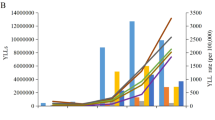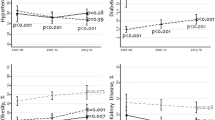Abstract
Aims
Chronic kidney disease (CKD) poses a significant health burden in the United States (US). Although earlier studies investigated income disparities in other chronic diseases, limited research has been carried out for CKD in recent years. We investigated income disparities in the prevalence and trends of CKD among US adults.
Subjects and methods
This cross-sectional study analyzed National Health and Nutrition Examination Survey 2003–18 data. Survey periods were grouped as 2003–06, 2007–10, 2011–14, and 2015–18. Using glomerular filtration rate and urinary albumin-creatinine ratio from CKD-epidemiology equation, individuals ≥20-year-old were classified into stages of CKD. Income was derived from family income to poverty ratio and equally stratified as low-, middle-, and high-income.
Results
In all periods, a reduction in CKD prevalence was observed as income-level increased. In 2003–06, the prevalence (95% confidence interval [CI]) of CKD was 17.8% (15.6%–20.3%), 14.7% (13.1%–16.4%), and 11.5% (10.3%–12.9%) among low-, middle-, and high-income people, respectively. It remained similar in 2007–10 and 2011–14. In 2015–18, this prevalence (95% CI) was 17.9% (16.5%–19.5%), 15.9% (14.6%–17.2%), and 10.2% (8.8%–11.8%) among low-, middle, and high-income people, respectively. Similar differences were detected across most age, gender, and race/ethnicity categories. Income differences were also observed in prevalence of CKD risk factors, including diabetes, obesity, metabolic syndrome, and smoking.
Conclusion
While there was no increase in overall CKD prevalence, there could be an association between CKD and income, and low- or middle-income people had higher prevalence of CKD than high-income people. Lifestyle intervention and chronic disease-related health service provision need to consider the income disparity in CKD burden to improve the health and wellbeing of the US population.
Similar content being viewed by others
Availability of Data
Data is freely available from Centers for Diseases Control and Prevention’s website.
References
Afkarian M, Zelnick LR, Hall YN et al (2016) Clinical manifestations of kidney disease among US adults with diabetes, 1988-2014. JAMA 316:602. https://doi.org/10.1001/jama.2016.10924
Al Kibria GM (2019) Racial/ethnic disparities in prevalence, treatment and control of hypertension among US adults following application of the 2017 American College of Cardiology/American Heart Association guideline. Prev Med Rep 14:100850. https://doi.org/10.1016/j.pmedr.2019.100850
Alberti KGMM, Eckel RH, Grundy SM et al (2009) Harmonizing the metabolic syndrome: a joint interim statement of the international diabetes federation task force on epidemiology and prevention; National Heart, Lung, and Blood Institute; American Heart Association; World Heart Federation; International Atherosclerosis Society; and International Association for the Study of Obesity. Circulation 120:1640–1645. https://doi.org/10.1161/CIRCULATIONAHA.109.192644
Assari S, Lankarani MM (2017) Income gradient in Renal disease mortality in the United States. Front Med 4:190. https://doi.org/10.3389/fmed.2017.00190
Banerjee S, Khadem K (2019) Factors influencing injury severity in alcohol-related crashes: a neural network approach using HSIS crash Data. ITE J 89
Centers for Disease Control and Prevention (2015) Chronic Kidney Disease. https://www.cdc.gov/kidneydisease/index.html
Centers for Disease Control and Prevention (2020a) Chronic kidney disease (CKD) surveillance system website. https://nccd.cdc.gov/ckd/default.aspx
Centers for Disease Control and Prevention (2020b) Healthy people 2020. https://www.cdc.gov/nchs/healthy_people/hp2020.htm
Chen TK, Knicely DH, Grams ME (2019) Chronic kidney disease diagnosis and management: a review. JAMA 322:1294. https://doi.org/10.1001/jama.2019.14745
Chetty R, Stepner M, Abraham S et al (2016) The association between income and life expectancy in the United States, 2001-2014. JAMA 315:1750–1766. https://doi.org/10.1001/jama.2016.4226
Cohen DA, Han B, Derose KP et al (2012) Neighborhood poverty, park use, and park-based physical activity in a Southern California city. Soc Sci Med 75:2317–2325. https://doi.org/10.1016/j.socscimed.2012.08.036
Heron M (2018) Deaths: leading causes for 2016. National vital statistics reports, vol. 67, no. 6. National Center for Health Statistics. https://www.cdc.gov/nchs/data/nvsr/nvsr68/nvsr68_07-508.pdf
Hoerger TJ, Simpson SA, Yarnoff BO et al (2015) The future burden of CKD in the United States: a simulation model for the CDC CKD initiative. Am J Kidney Dis 65:403–411. https://doi.org/10.1053/j.ajkd.2014.09.023
Jackson SL, Yang EC, Zhang Z (2018) Income disparities and cardiovascular risk factors among adolescents. Pediatrics 142:e20181089. https://doi.org/10.1542/peds.2018-1089
Kang H (2013) The prevention and handling of the missing data. Korean J Anesthesiol 64:402. https://doi.org/10.4097/kjae.2013.64.5.402
Khosla T, Lowe CR (1967) Indices of obesity derived from body weight and height. Br J Prev Soc Med 21:122–128. https://doi.org/10.1136/jech.21.3.122
Kibria GMA, Crispen R (2020) Prevalence and trends of chronic kidney disease and its risk factors among US adults: an analysis of NHANES 2003-18. Prev Med Rep 20:101193. https://doi.org/10.1016/j.pmedr.2020.101193
Levey AS, Stevens LA, Schmid CH et al (2009) A new equation to estimate glomerular filtration rate. Ann Intern Med 150:604–612
Moore JX, Chaudhary N, Akinyemiju T (2017) Metabolic syndrome prevalence by race/ethnicity and sex in the United States, National Health and Nutrition Examination Survey, 1988–2012. Prev Chronic Dis 14. https://doi.org/10.5888/pcd14.160287
Murphy D, McCulloch CE, Lin F et al (2016) Trends in prevalence of chronic kidney disease in the United States. Ann Intern Med 165:473. https://doi.org/10.7326/M16-0273
National Center for Health Statistics (2017) NCHS Research Ethics Review Board (ERB) Approval. https://www.cdc.gov/nchs/nhanes/irba98.htm. Accessed 11 Sep 2018
National Center for Health Statistics (2020) National health and nutrition examination survey. https://www.cdc.gov/nchs/nhanes/index.htm
Nicholas SB, Kalantar-Zadeh K, Norris KC (2015) Socioeconomic disparities in chronic kidney disease. Adv Chronic Kidney Dis 22:6–15. https://doi.org/10.1053/j.ackd.2014.07.002
Odutayo A, Gill P, Shepherd S et al (2017) Income disparities in absolute cardiovascular risk and cardiovascular risk factors in the United States, 1999-2014. JAMA Cardiol 2:782. https://doi.org/10.1001/jamacardio.2017.1658
Ostchega Y, Zhang G, Hughes JP, Nwankwo T (2018) Factors associated with hypertension control in US adults using 2017 ACC/AHA guidelines: National Health and nutrition examination survey 1999–2016. Am J Hypertens 31:886–894. https://doi.org/10.1093/ajh/hpy047
Pool LR, Ning H, Lloyd-Jones DM, Allen NB (2017) Trends in racial/ethnic disparities in cardiovascular health among US adults from 1999–2012. J Am Heart Assoc 6. https://doi.org/10.1161/JAHA.117.006027
Stata Corporation, College Station, Texas USA (2017) StataCorp. 2017. https://www.stata.com/support/faqs/resources/citing-software-documentation-faqs/. Accessed 8 May 2017
Timonin S, Shkolnikov VM, Jasilionis D et al (2016) Disparities in length of life across developed countries: measuring and decomposing changes over time within and between country groups. Popul Health Metrics 14:29. https://doi.org/10.1186/s12963-016-0094-0
U.S. Department of Health & Human Services (2019) Poverty guidelines. https://aspe.hhs.gov/poverty-guidelines. Accessed 16 Feb 2019
United States Census Bureau (2019) Population Distribution.https://www.census.gov/data/datasets/2017/demo/popest/nation-detail.html. Accessed 20 Feb 2020
US Renal Data System (2019) US Renal Data System 2019 annual data report: epidemiology of kidney disease in the United States. https://doi.org/10.1053/j.ajkd.2019.09.003
Whelton PK, Carey RM, Aronow WS, et al (2018) 2017 ACC/AHA/AAPA/ABC/ACPM/AGS/APhA/ASH/ASPC/NMA/PCNA guideline for the prevention, detection, evaluation, and management of high blood pressure in adults: a report of the American College of Cardiology/American Heart Association Task Force on Clinical Practice Guidelines. Hypertension 71:e13–e115. https://doi.org/10.1161/HYP.0000000000000065
Wu B, Bell K, Stanford A et al (2016) Understanding CKD among patients with T2DM: prevalence, temporal trends, and treatment patterns—NHANES 2007–2012. BMJ Open Diabetes Res Care 4:e000154. https://doi.org/10.1136/bmjdrc-2015-000154
Acknowledgements
We did not use any copyrighted materials, instruments, tools, data, or surveys, and thank all survey participants.
Funding
No funding was received.
Author information
Authors and Affiliations
Contributions
Conception and design: G. Kibria.
Analysis and interpretation of the data: G. Kibria and Z. Hasan.
Drafting of the article: G. Kibria.
Critical revision of the article for important intellectual content: Z. Hasan.
Final approval of the article: G. Kibria and Z. Hasan.
Dr. Kibria had full access to the research and writing processes and takes responsibility for the integrity of the paper.
Corresponding author
Ethics declarations
Conflict of interest
The authors declare that they have no conflict of interest to disclose.
Additional information
Publisher’s note
Springer Nature remains neutral with regard to jurisdictional claims in published maps and institutional affiliations.
Supplementary Information
ESM 1
(DOCX 13 kb)
Rights and permissions
About this article
Cite this article
Al Kibria, G.M., Hasan, M.Z. Income disparities in prevalence and trends of chronic kidney disease among US adults, 2003–18. J Public Health (Berl.) 30, 2181–2189 (2022). https://doi.org/10.1007/s10389-021-01505-1
Received:
Accepted:
Published:
Issue Date:
DOI: https://doi.org/10.1007/s10389-021-01505-1




